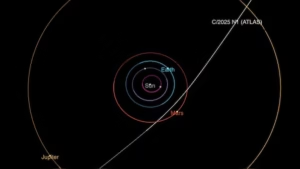
interstellar comet
NASA Spots Rare Interstellar Comet 3I/ATLAS Entering Solar System
A cosmic outsider — 3I/ATLAS — becomes only the third known interstellar visitor as it travels through our planetary neighborhood.
🚀 What Is 3I/ATLAS and Why Is It Unique?
NASA has officially confirmed the detection of a new interstellar comet, designated 3I/ATLAS (also known as C/2025 N1). It is only the third such object ever observed, following ‘Oumuamua in 2017 and 2I/Borisov in 2019. This cosmic traveler is not bound by the Sun’s gravity — it hails from outside our solar system, making its journey on a hyperbolic trajectory. Spotted by the ATLAS telescope in Chile on 1 July 2025, its earlier traces were found in images dating back to June 14. Astronomers estimate it is traveling at speeds exceeding 60 km/s — roughly 37 miles per second.🔭 Path Through the Solar System
At the time of its confirmation, 3I/ATLAS was located approximately 4.5 astronomical units (AU) from the Sun — that’s about 670 million kilometers. It is expected to reach its perihelion (closest point to the Sun) around October 29, 2025, when it will come within 1.36 AU, near the orbit of Mars. After perihelion, the comet will make its closest approach to Earth around mid-December 2025. However, it will stay at a safe distance — more than 1.6 AU (≈240 million km) from our planet — posing no threat.🌌 How Do We Know It’s Interstellar?
The hyperbolic orbit of 3I/ATLAS means it is not gravitationally bound to the Sun. That’s the hallmark of an interstellar object. Its extremely high orbital eccentricity — greater than 1 — confirms it’s a true outsider. Unlike traditional solar system comets, this one wasn’t born from our local celestial mechanics. Instead, it likely originated from the planetary debris disk of a distant star system and was ejected millions of years ago.🛰️ Comet or Asteroid?
Though early images showed a starlike object, subsequent observations revealed a faint **coma** and short **tail**, confirming its cometary nature. Hence, it carries the dual designation — 3I (interstellar) and C/2025 N1 (comet). This is a notable contrast to ‘Oumuamua, which displayed no comet-like activity, and Borisov, which had a visible tail but with different composition signatures.📅 Timeline of Key Events
| Event | Date |
|---|---|
| Discovered by ATLAS telescope | 1 July 2025 |
| Perihelion (closest to Sun) | 29 October 2025 |
| Closest to Earth | Mid-December 2025 |
| Exit from Solar System | Early 2026 |
🔬 Why This Comet Matters
This interstellar comet offers scientists a rare glimpse into extrastellar materials. Studying its composition — from isotopic signatures to gas and dust ratios — helps researchers understand how other solar systems form and evolve. It also provides insight into how planetary systems eject objects during their chaotic early phases, contributing to our knowledge of celestial dynamics beyond our Sun’s reach.🔭 How You Can Observe It
- The Virtual Telescope Project is hosting a live stream of 3I/ATLAS starting from 3 July 2025.
- From October onwards, observers with mid-range telescopes may be able to spot the comet as it brightens near perihelion.
- Skywatching apps and astronomy clubs are expected to release coordinates and viewing tips throughout the year.
🧪 Scientific Goals and Global Collaboration
The arrival of 3I/ATLAS has sparked coordinated efforts among observatories around the world. NASA, the European Southern Observatory, and Japan’s Subaru Telescope are pooling resources to track and analyze the object’s speed, light curve, and spectral properties. This global collaboration aims to decode the comet’s chemical makeup, including isotopes and volatile elements, to determine whether it formed in a solar-like system or a chemically distinct stellar nursery. These insights can dramatically expand our understanding of planetary evolution and star system diversity across the galaxy.✅ Final Thoughts
The arrival of 3I/ATLAS is a celestial headline for 2025. While it poses no threat to Earth, it offers an incredible opportunity to understand the universe beyond our solar bubble. From professional astronomers to backyard skywatchers, the interstellar visitor is capturing global curiosity, reminding us how small, yet interconnected, our solar system truly is. Stay tuned to TrendyIndiaNews.com for more astronomical updates, NASA mission news, and space discoveries!About The Author
Discover more from Trendy India News
Subscribe to get the latest posts sent to your email.





